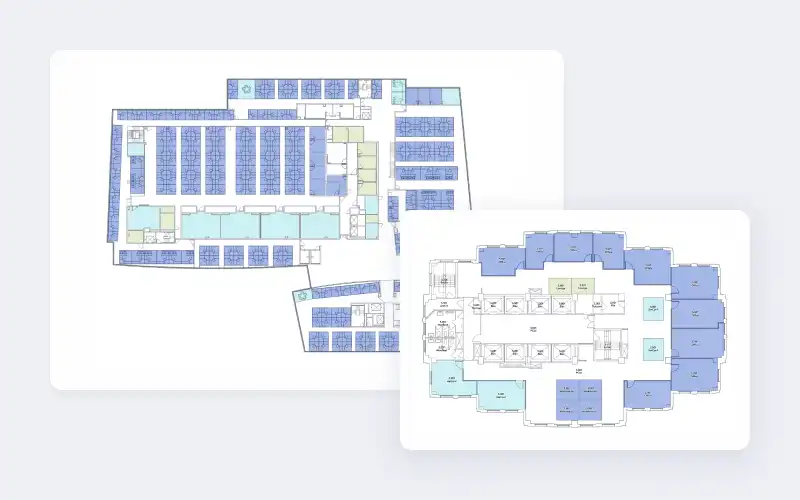
Healthcare facilities face constantly growing cost pressures. In the US, total hospital expenses grew 5.1% in 2024, significantly outpacing overall inflation, according to the American Hospital Association, while healthcare systems around the world also struggle with government funding cuts. Space planning can help healthcare facilities optimize their facilities to reduce costs, ensuring they continue to provide high-quality care while improving operational efficiency.
Why is space planning important for government-run and for-profit healthcare facilities?
Quality of care is a fundamental metric at all healthcare facilities. At for-profit facilities, leadership understands the direct connections between quality of care and revenue, including increased patient volume, improved reputation, and reduced costs. At government-run facilities, delivering a high standard of quality of care supports improved health outcomes, efficient resource allocation, and builds trust in the healthcare system.
In the end, any differences between healthcare providers are only surface deep. At their core, these facilities focus on patient well-being. By providing high-quality care, healthcare providers can significantly improve outcomes, ensuring patients receive the most effective treatments and preventive services. Ultimately, the goal is to create a healthcare environment where every patient feels valued and supported.
Poor space planning and the ways it impacts patients, healthcare providers, and facility management teams makes reaching this goal significantly more difficult.
Inefficient workflows
When rooms and areas are not strategically located, staff spend too much time moving between locations, searching for essential equipment or supplies, or waiting for resources to become available. This not only increases the workload and stress on healthcare providers but also delays patient care, potentially leading to poorer outcomes. For example, if a nurse needs to walk long distances to retrieve medication or if a doctor has to wait for a diagnostic machine to be freed up, the overall patient experience can suffer. Efficient workflows are crucial for ensuring that healthcare providers can focus on what matters most: delivering high-quality, timely care to their patients.
In fact, nurses reported an average of one work design issue per hour, with 39% of these problems resulting in an average 90-minute delay in patient care, according to a study cited by the National Institutes of Health.
Increased maintenance and repair costs
Unnecessary or poorly utilized spaces in healthcare facilities can lead to a range of operational issues. These spaces often result in higher energy consumption, increased maintenance costs, and overall higher operational expenses. For example, an underused conference room or a rarely accessed storage area can consume valuable resources that could be better allocated to patient care areas.
Poorly designed facilities are also more likely to require more frequent repairs. Patient rooms that are not designed with durability and ease of cleaning in mind can deteriorate faster, leading to more maintenance needs. Similarly, if the layout is not conducive to the flow of patients and staff, it can cause wear and tear on floors, walls, and other infrastructure. The combination of redundant spaces and increased maintenance strains the facility’s budget and resources, making it difficult to maintain a safe and functional environment for both patients and staff.
How can space planning help healthcare facilities improve patient care and operational efficiency?
By carefully designing and then continuously monitoring the physical environment, healthcare providers can create spaces that not only promote safety and reduce the risk of infections but also streamline patient flow and foster stronger collaboration among staff. Effective space planning ensures that every area serves its intended purpose, from exam rooms to waiting areas, leading to a more compassionate and efficient healthcare experience.
Improved patient safety and infection control
Separating patient zones, optimizing hand hygiene stations, and reducing overcrowding can help minimize the risk of infection by controlling the spread of pathogens and ensuring that infection control practices are followed effectively. Single-patient rooms are particularly effective in reducing the risk of hospital-acquired infections. Strategic design elements, such as standardized room layouts and improved visibility of patients, can help prevent falls by ensuring that healthcare providers can quickly and easily monitor patients. Efficient layouts can also reduce the potential for medical errors by improving communication and minimizing distractions, which is essential for maintaining a high standard of patient care.
Smoother patient flow
Strategic placement of exam rooms, waiting areas, and diagnostic testing areas can minimize patient travel and reduce wait times. For example, placing diagnostic testing areas near exam rooms can streamline the process, allowing patients to move through their appointments more quickly and efficiently. This reduces the time patients spend moving around the facility, which can be particularly beneficial for those with mobility issues related to impairment of discomfort.
Stronger staff collaboration and communication
Spaces that facilitate communication and collaboration among staff can improve teamwork and patient care. For example, having a centralized area for staff meetings and shift changes can enhance communication and coordination. Open and accessible design elements, such as glass windows in doors, can also promote a more collaborative and transparent work environment, which is essential for delivering high-quality care.
Designated spaces for communication between healthcare providers, patients, and families can improve collaboration and information sharing. These spaces can include private consultation rooms and areas where healthcare teams can meet to discuss patient care plans. By providing dedicated areas for these interactions, healthcare providers can ensure that information is communicated clearly and effectively, leading to better patient outcomes and higher satisfaction.
What are the key features and benefits of space planning solutions for healthcare?
By leveraging advanced tools and strategies, healthcare facilities can create spaces where every aspect of the facility contributes to a seamless and supportive healthcare experience, from the moment patients, visitors, and staff arrive.
Visualize and stack floor plans
Visualizing and stacking floor plans allows healthcare facilities to see the layout of their spaces in a clear, organized manner, so you can understand how different areas are connected and how they can be used more effectively. By stacking floor plans, you can compare multiple levels or wings of a building, making it easier to identify patterns and inefficiencies. For example, if you notice that certain patient rooms are consistently underused while others are overcrowded, you can make informed decisions to redistribute patients or staff. Having an easy way to visualize your data helps when planning and decision-making, ensuring that every part of the facility is used to its full potential.
Track occupancy to optimize space utilization
Implementing space planning software means you can monitor how many people are using each area at any given time, helping you understand peak hours and low-traffic periods. These insights are invaluable for scheduling staff, allocating resources, and ensuring that patient care areas are not overcrowded. For example, if you see that a particular wing of the hospital is always full during the morning shift, you can adjust staffing levels to better meet demand. Or you might convert a rarely used conference room into a telehealth station or a patient consultation area. By keeping a close eye on occupancy, you can also identify underutilized spaces that can be repurposed, leading to cost savings and improved patient care.
Facilitate real estate expansion, reconfiguration, and equipment integration
Facilities can leverage space planning software when planning and implementing capital projects. For example, if you need to expand a department or integrate new medical equipment, the software can simulate different scenarios to find the best layout, ensuring you’re making changes that maximize efficiency and minimize disruption.

Successful space planning at government healthcare facility: How repurposing a single 330-square-foot room saved $8.3 million annually
A government healthcare organization faced a rising demand for space with limited resources. Various divisions within the organization wanted more room to expand their services, and an influx of new patients was increasing the need to optimize existing facilities. The result was inefficient space utilization and high costs for outsourced services, which also impacted the quality of patient care.
To overcome these challenges, the organization implemented space management technology. This software solution provided a comprehensive inventory of their space, so the facility team knew exactly what staff and patients were using and how, a critical first step in identifying and repurposing underutilized areas.
Space planning solution features used in this strategic initiative included:
- Comprehensive space inventory: Detailed overview of all available spaces within the facility, allowing the team to understand the current utilization and identify areas for improvement
- Centralized reporting platform: Real-time data and insights that help the facility management team to monitor space usage and make informed decisions
- Space repurposing tools: Advanced capabilities to redesign and reassign spaces to better meet the needs of patients and staff, ensuring higher utilization rates
One of the most impactful changes was the conversion of a 330-square-foot room from an occasional X-ray space to a versatile infusion treatment area, resulting in annual savings of $8.3 million. The repurposed room not only saved money but also improved patient care by bringing essential services in-house, enhancing accessibility, and the overall patient experience.
By leveraging advanced space management solutions, the healthcare organization saw significant financial savings and created a more efficient, patient-centric environment.









